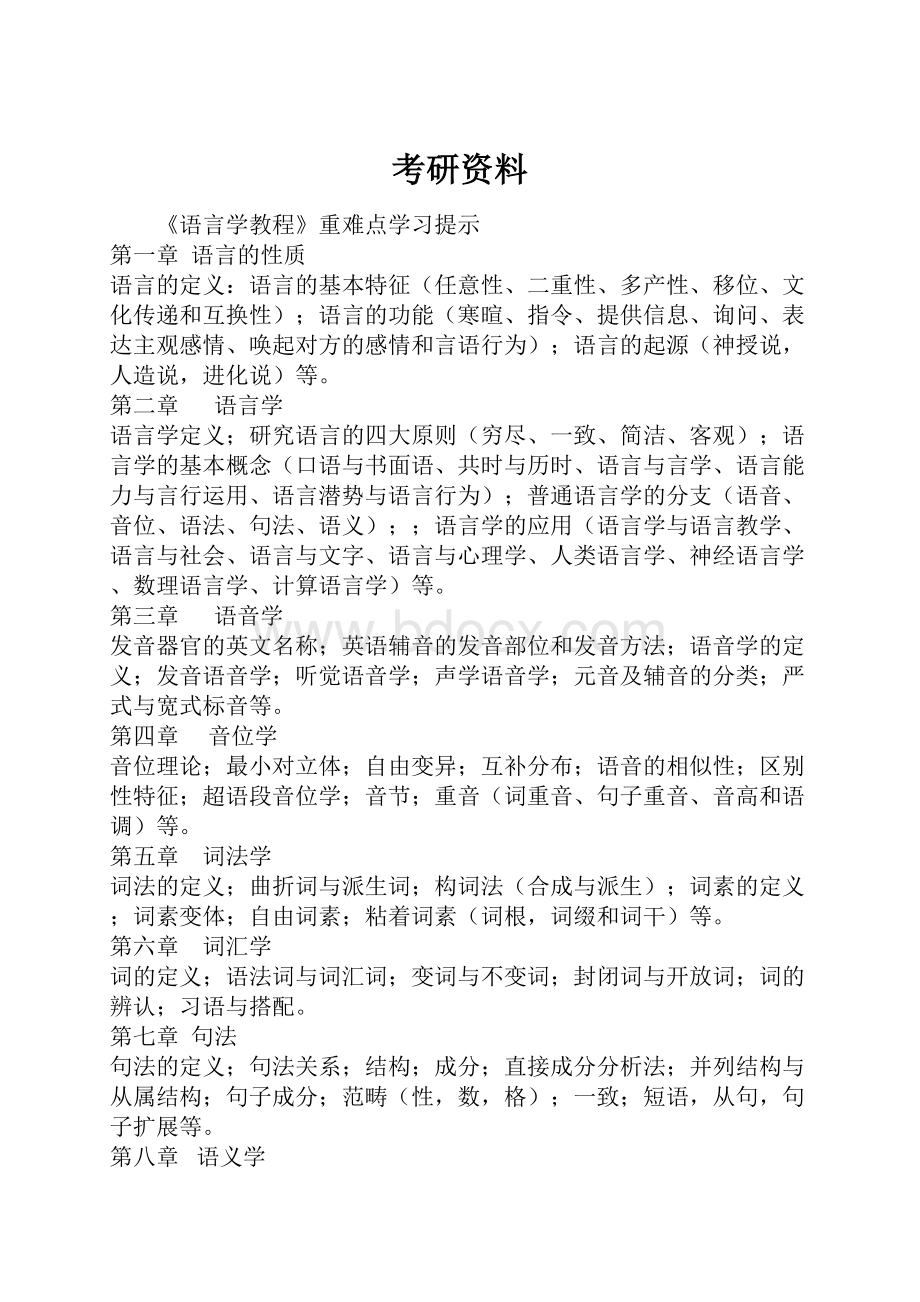 考研资料.docx
考研资料.docx
- 文档编号:25766035
- 上传时间:2023-06-13
- 格式:DOCX
- 页数:30
- 大小:40.75KB
考研资料.docx
《考研资料.docx》由会员分享,可在线阅读,更多相关《考研资料.docx(30页珍藏版)》请在冰豆网上搜索。

考研资料
《语言学教程》重难点学习提示
第一章 语言的性质
语言的定义:
语言的基本特征(任意性、二重性、多产性、移位、文化传递和互换性);语言的功能(寒暄、指令、提供信息、询问、表达主观感情、唤起对方的感情和言语行为);语言的起源(神授说,人造说,进化说)等。
第二章 语言学
语言学定义;研究语言的四大原则(穷尽、一致、简洁、客观);语言学的基本概念(口语与书面语、共时与历时、语言与言学、语言能力与言行运用、语言潜势与语言行为);普通语言学的分支(语音、音位、语法、句法、语义);;语言学的应用(语言学与语言教学、语言与社会、语言与文字、语言与心理学、人类语言学、神经语言学、数理语言学、计算语言学)等。
第三章 语音学
发音器官的英文名称;英语辅音的发音部位和发音方法;语音学的定义;发音语音学;听觉语音学;声学语音学;元音及辅音的分类;严式与宽式标音等。
第四章 音位学
音位理论;最小对立体;自由变异;互补分布;语音的相似性;区别性特征;超语段音位学;音节;重音(词重音、句子重音、音高和语调)等。
第五章 词法学
词法的定义;曲折词与派生词;构词法(合成与派生);词素的定义;词素变体;自由词素;粘着词素(词根,词缀和词干)等。
第六章 词汇学
词的定义;语法词与词汇词;变词与不变词;封闭词与开放词;词的辨认;习语与搭配。
第七章 句法
句法的定义;句法关系;结构;成分;直接成分分析法;并列结构与从属结构;句子成分;范畴(性,数,格);一致;短语,从句,句子扩展等。
第八章 语义学
语义的定义;语义的有关理论;意义种类(传统、功能、语用);里奇的语义分类;词汇意义关系(同义、反义、下义);句子语义关系。
第九章 语言变化
语言的发展变化(词汇变化、语音书写文字、语法变化、语义变化);
第十章 语言、思维与文化
语言与文化的定义;萨丕尔-沃夫假说;语言与思维的关系;语言与文化的关系;中西文化的异同。
第十一章 语用学
语用学的定义;语义学与语用学的区别;语境与意义;言语行为理论(言内行为、言外行为和言后行为);合作原则。
1.1. Whatislanguage?
“Languageissystemofarbitraryvocalsymbolsusedforhumancommunication.Itisasystem,sincelinguisticelementsarearrangedsystematically,ratherthanrandomly.Arbitrary,inthesensethatthereisusuallynointrinsicconnectionbetweenawork(like“book”)andtheobjectitrefersto.Thisexplainsandisexplainedbythefactthatdifferentlanguageshavedifferent“books”:
“book”inEnglish,“livre”inFrench,inJapanese,inChinese,“check”inKorean.Itissymbolic,becausewordsareassociatedwithobjects,actions,ideasetc.bynothingbutconvention.Namely,peopleusethesoundsorvocalformstosymbolizewhattheywishtoreferto.Itisvocal,becausesoundorspeechistheprimarymediumforallhumanlanguages,developedor“new”.Writingsystemscamemuchlaterthanthespokenforms.Thefactthatsmallchildrenlearnandcanonlylearntospeak(andlisten)beforetheywrite(andread)alsoindicatesthatlanguageisprimarilyvocal,ratherthanwritten.Theterm“human”inthedefinitionismeanttospecifythatlanguageishumanspecific.
1.2. Whataredesignfeaturesoflanguage?
“Designfeatures”hererefertothedefiningpropertiesofhumanlanguagethattellthedifferencebetweenhumanlanguageandanysystemofanimalcommunication.Theyarearbitrariness,duality,productivity,displacement,culturaltransmissionandinterchangeability
1.3. Whatisarbitrariness?
By“arbitrariness”,wemeanthereisnologicalconnectionbetweenmeaningsandsounds(seeI.1).Adogmightbeapigifonlythefirstpersonorgroupofpersonshaduseditforapig.Languageisthereforelargelyarbitrary.Butlanguageisnotabsolutelyseemtobesomesound-meaningassociation,ifwethinkofechowords,like“bang”,“crash”,“roar”,whicharemotivatedinacertainsense.Secondly,somecompounds(wordscompoundedtobeoneword)arenotentirelyarbitraryeither.“Type”and“write”areopaqueorunmotivatedwords,while“type-writer”islessso,ormoretransparentormotivatedthanthewordsthatmakeit.Sowecansay“arbitrariness”isamatterofdegree.
1.4.Whatisduality?
Linguistsrefer“duality”(ofstructure)tothefactthatinalllanguagessofarinvestigated,onefindstwolevelsofstructureorpatterning.Atthefirst,higherlevel,languageisanalyzedintermsofcombinationsofmeaningfulunits(suchasmorphemes,wordsetc.);atthesecond,lowerlevel,itisseenasasequenceofsegmentswhichlackanymeaninginthemselves,butwhichcombinetoformunitsofmeaning.AccordingtoHuZhanglinetal.(p.6),languageisasystemoftwosetsofstructures,oneofsoundsandtheotherofmeaning.Thisisimportantfortheworkingsoflanguage.Asmallnumberofsemanticunits(words),andtheseunitsofmeaningcanbearrangedandrearrangedintoaninfinitenumberofsentences(notethatwehavedictionariesofwords,butnodictionaryofsentences!
).Dualitymakesitpossibleforapersontotalkaboutanythingwithinhisknowledge.Noanimalcommunicationsystemenjoysthisduality,orevenapproachesthishonour.
1.5.Whatisproductivity?
Productivityreferstotheabilitytotheabilitytoconstructandunderstandanindefinitelylargenumberofsentencesinone’snativelanguage,includingthosethathasneverheardbefore,butthatareappropriatetothespeakingsituation.Noonehaseversaidorheard“Ared-eyedelephantisdancingonthesmallhotelbedwithanAfricangibbon”,buthecansayitwhennecessary,andhecanunderstanditinrightregister.Differentfromartisticcreativity,though,productivitynevergoesoutsidethelanguage,thusalsocalled“rule-boundcreativity”(byN.Chomsky).
1.6.Whatisdisplacement?
“Displacement”,asoneofthedesignfeaturesofthehumanlanguage,referstothefactthatonecantalkaboutthingsthatarenotpresent,aseasilyashedoesthingspresent.Inotherwords,onecanrefertorealandunrealthings,thingsofthepast,ofthepresent,ofthefuture.Languageitselfcanbetalkedabouttoo.Whenaman,forexample,iscryingtoawoman,aboutsomething,itmightbesomethingthathadoccurred,orsomethingthatisoccurring,orsomethingthatistooccur.Whenadogisbarking,however,youcandecideitisbarkingforsomethingoratsomeonethatexistsnowandthere.Itcouldn’tbebow-wowingsorrowfullyfordomelostloveorabonetobelost.Thebee’ssystem,nonetheless,hasasmallshareof“displacement”,butitisanunspeakabletinyshare.
1.7.Whatisculturaltransmission?
Thismeansthatlanguageisnotbiologicallytransmittedfromgenerationtogeneration,butthatthedetailsofthelinguisticsystemmustbelearnedanewbyeachspeaker.Itistruethatthecapacityforlanguageinhumanbeings(N.Chomskycalledit“languageacquisitiondevice”,orLAD)hasageneticbasis,buttheparticularlanguageapersonlearnstospeakisaculturaloneotherthanageneticonelikethedog’sbarkingsystem.Ifahumanbeingisbroughtupinisolationhecannotacquirelanguage.TheWolfChildrearedbythepackofwolvesturnedouttospeakthewolf’sroaring“tongue”whenhewassaved.Helearnedthereafter,withnosmalldifficulty,theABCofacertainhumanlanguage.
1.8.Whatisinterchangeability?
Interchangeabilitymeansthatanyhumanbeingcanbebothaproducerandareceiverofmessages.Wecansay,andonotheroccasionscanreceiveandunderstand,forexample,“Pleasedosomethingtomakemehappy.”Thoughsomepeople(includingme)suggestthatthereissexdifferentiationintheactuallanguageuse,inotherwords,menandwomenmaysaydifferentthings,yetinprinciplethereisnosound,orwordorsentencethatamancanutterandawomancannot,orviceversa.Ontheotherhand,apersoncanbethespeakerwhiletheotherpersonisthelistenerandastheturnmovesontothelistener,hecanbethespeakerandthefirstspeakeristolisten.Itisturn-takingthatmakessocialcommunicationpossibleandacceptable.
Somemalebirds,however,uttersomecallswhichfemalesdonot(orcannot?
),andcertainkindsoffishhavesimilarhapsmentionable.Whenadogbarks,alltheneighbouringdogsbark.Thenpeoplearoundcanhardlytellwhichdog(dogs)is(are0“speaking”andwhichlistening.
1.9.Whydolinguistssaylanguageishumanspecific?
Firstofall,humanlanguagehassix“designfeatures”whichanimalcommunicationsystemsdonothave,atleastnotinthetruesenseofthem(seeI.2-8).Let’sborrowC.F.Hocket’sChartthatcompareshumanlanguagewithsomeanimals’systems,fromWangGang(1998,p.8).
Secondly,linguistshavedonealottryingtoteachanimalssuchaschimpanzeestospeakahumanlanguagebuthaveachievednothinginspiring.Washoe,afemalechimpanzee,wasbroughtuplikeahumanchildbyBeatniceandAlanGardner.Shewastaught“AmericansignLanguage”,andlearnedalittlethatmadetheteachershappybutdidmotmakethelinguisticscirclehappy,forfewbelievedinteachingchimpanzees.
Thirdly,ahumanchildrearedamonganimalscannotspeakahumanlanguage,notevenwhenheistakenbackandtaughttolotoso(seethe“WolfChild”inI.7)
1.10.Whatfunctionsdoeslanguagehave?
Languagehasatleastsevenfunctions:
phatic,directive,Informative,interrogative,expressive,evocativeandperformative.AccordingtoWangGang(1988,p.11),languagehasthreemainfunctions:
atoolofcommunication,atoolwherebypeoplelearnabouttheworld,andatoolbywhichpeoplelearnabouttheworld,andatoolbywhichpeoplecreateart.M.A.K.Halliday,representativeoftheLondonschool,recognizesthree“Macro-Functions”:
ideational,interpersonalandtextual(see!
.11-17;seeHUZhuanglinetal.,pp10-13,pp394-396).1. 11Whatisthephaticfunction?
The“phaticfunction”referstolanguagebeingusedforsettingupacertainatmosphereormaintainingsocialcontacts(ratherthanforexchanginginformationorideas).Greetings,farewells,andcommentsontheweatherinEnglishandonclothinginChineseallservethisfunction.Muchofthephaticlanguage(e.g.“Howareyou?
”“Fine,thanks.”)isinsincereiftakenliterally,butitisimportant.Ifyoudon'tsay“Hello”toafriendyoumeet,orifyoudon’tanswerhis“Hi”,youruinyourfriendship.
1.12. Whatisthedirectivefunction?
The“directivefunction”meansthatlanguagemaybeusedtogetthehearertodosomething.Mostimperativesentencesperformthisfunction,e.g.,“Tellmetheresultwhenyoufinish.”Othersyntacticstructuresorsentencesofothersortscan,accordingtoJ.AustinandJ.Searle’s“indrectspeechacttheory”(seeHuZhuanglinetal.,pp271-278)atleast,servethepurposeofdirectiontoo,e.g.,“IfIwereyou,Iwouldhaveblushedtothebottomofmyears!
”
1.13.Whatistheinformativefunction?
Languageservesan“inf
- 配套讲稿:
如PPT文件的首页显示word图标,表示该PPT已包含配套word讲稿。双击word图标可打开word文档。
- 特殊限制:
部分文档作品中含有的国旗、国徽等图片,仅作为作品整体效果示例展示,禁止商用。设计者仅对作品中独创性部分享有著作权。
- 关 键 词:
- 考研 资料
 冰豆网所有资源均是用户自行上传分享,仅供网友学习交流,未经上传用户书面授权,请勿作他用。
冰豆网所有资源均是用户自行上传分享,仅供网友学习交流,未经上传用户书面授权,请勿作他用。


 《爱和自由》读书心得15篇.docx
《爱和自由》读书心得15篇.docx
